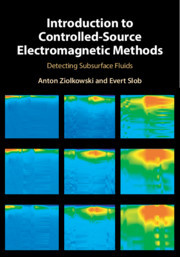Introduction to Controlled-Source Electromagnetic Methods Detecting Subsurface Fluids
Langue : Anglais
Auteurs : Ziolkowski Anton, Slob Evert

An introduction to the theory and practical application of CSEM methods to explore whether subsurface structures contain hydrocarbons.
This volume describes how controlled-source electromagnetic (CSEM) methods are used to determine the electrical conductivity and hydrocarbon content of the upper few kilometres of the Earth, on land and at sea. The authors show how the signal-to-noise ratio of the measured data may be maximised via suitable choice of acquisition and processing parameters and selection of subsequent data analysis procedures. Complete impulse responses for every electric and magnetic source and receiver configuration are derived, providing a guide to the expected response for real data. 1-D, 2-D and 3-D modelling and inversion procedures for recovery of Earth conductivity are presented, emphasising the importance of updating model parameters using complementary geophysical data and rock physics relations. Requiring no specialist prior knowledge of electromagnetic theory, and providing a step-by-step guide through the necessary mathematics, this book provides an accessible introduction for advanced students, researchers and industry practitioners in exploration geoscience and petroleum engineering.
Preface; Notation and conventions; 1. Introduction; 2. Sources, receivers, acquisition configurations and source time functions; 3. Fourier analysis and linear filters; 4. Electromagnetic fields in a horizontally layered VTI medium; 5. Numerical examples; 6. Source control; 7. Deep-water CSEM; 8. Land CSEM with a transient source signal; 9. Shallow-water CSEM with a transient source signal; 10. Forward and inverse modelling of CSEM data; 11. Recovery of resistivities from CSEM data; 12. Efficient CSEM; Appendix A. The electric field in a VTI whole space; Appendix B. The electromagnetic field in a VTI layered medium; Appendix C. Green's functions and their derivatives; Appendix D. The final value theorem; References; Index.
Anton Ziolkowski is Professor of Petroleum Geoscience at the University of Edinburgh. He co-invented the Multichannel Transient Electromagnetic (MTEM) surveying method for hydrocarbon reservoir detection and co-led the technology spin-out. He is a member of the Institute of Electrical and Electronics Engineers and the American Geophysical Union, an honorary member of the Society of Exploration Geophysicists, a Fellow of the Royal Academy of Engineering, and a Fellow of the Royal Society of Edinburgh. He has received the Conrad Schlumberger and Desiderius Erasmus awards of the European Association of Geoscientists and Engineers.
Evert Slob is Professor of Geophysical Electromagnetic Methods at theTechnische Universiteit Delft, The Netherlands, where he teaches undergraduate and graduate classes. He was Editor-in-chief of the journal Geophysics and on the board of directors of the Society of Exploration Geophysicists from 2013–15, of which he remains a member. He is also a member of the European Association of Geoscientists and Engineers, and the American Geophysical Union.
Evert Slob is Professor of Geophysical Electromagnetic Methods at theTechnische Universiteit Delft, The Netherlands, where he teaches undergraduate and graduate classes. He was Editor-in-chief of the journal Geophysics and on the board of directors of the Society of Exploration Geophysicists from 2013–15, of which he remains a member. He is also a member of the European Association of Geoscientists and Engineers, and the American Geophysical Union.
Date de parution : 03-2019
Ouvrage de 332 p.
17.8x25.3 cm
Thème d’Introduction to Controlled-Source Electromagnetic Methods :
© 2024 LAVOISIER S.A.S.



